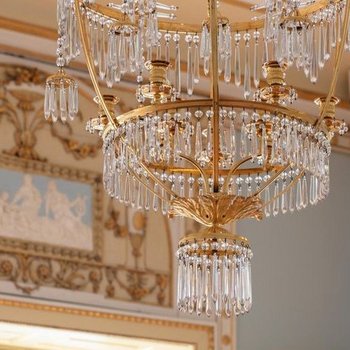3D printing, as additive manufacturing is popularly known, has now made its way into the manufacturing of ceramic products. Additive processes are primarily used to produce technical components that cannot be manufactured using conventional ceramic forming methods due to their geometric complexity. When the SKD’s Porzellansammlung (Porcelain Collection) enquired at Fraunhofer IKTS whether methods of this kind could also be used to restore historical works of art, this thus immediately piqued the interest of the workers involved in 3D printing at the institute.
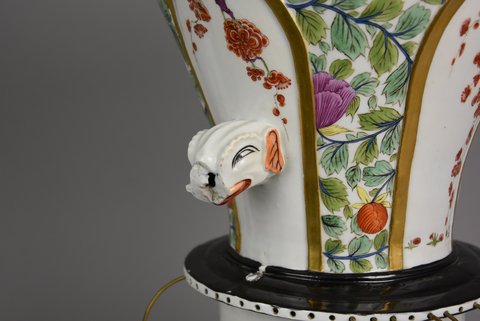
Detailansicht der Bruchstelle © Staatliche Kunstsammlungen Dresden, Porzellansammlung, Foto: Heike Ulbricht
Under the ZIM funding initiative run by the Federal Ministry for Economic Affairs and Climate Action (Grant Number ZF4076454AG9), a 3D porcelain printing method was to be developed for restoration work and applied to a suitable exhibit at the Porzellansammlung. The item selected was an elephant’s trunk, which had been missing from its owner’s head for more than 200 years. Alongside another elephant with an intact trunk, the pachyderm adorns a vase made at the Meissen Porcelain Manufactory in the 18th century.
Out of several additive manufacturing methods that are suitable for ceramics, a lithographic process was selected that experts call “vat photopolymerisation”. The first step in this method is to stir the porcelain powder into a special synthetic resin. One characteristic of this synthetic resin is that when various additives are admixed, and light of a certain wavelength is shone on it – in our case blue light with a wavelength of 452–465 nm – it hardens like the synthetic resin fillings sometimes used in dentistry. Small quantities of this relatively liquid mixture containing ceramic powder are poured into a glass vat that rotates under a fixed recoater blade. This rotating movement spreads a very thin, uniform layer of mixture over the bottom of the vat. The build platform itself is positioned above the vat. The item, hanging upside down, is built up on the platform layer by layer. The platform moves down and dips into the thin layer of mixed powder and synthetic resin. A digital light processing (DLP) module shines light on the section of the layer currently being built, rather like a projector. Within seconds, the synthetic resin hardens, creating a new layer of the component that is just a few micrometres thick. The build platform now briefly lifts above the glass vat, which rotates again under the recoater blade to apply a new layer of powder and synthetic resin. The build step is then repeated and the next layer of the component is cured. Thus, the desired component is created out of thousands of layers. Depending on the height of the part, the build process can take anything from hours to days.
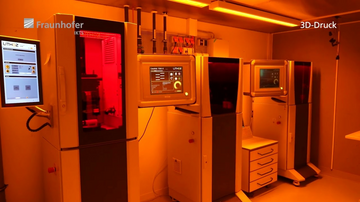
The part that is created by the end of that time is, however, not ceramic, but a plastic object with a high particle content, and thus not the ultimate aim of the restoration work. This object, known as a green body, now has to be cleaned thoroughly to remove any lingering traces of mixed powder and synthetic resin that have not been cured. The synthetic resin is then removed from the part. This step in the process is called “debinding” and involves thermally decomposing the synthetic resin by heating it extremely slowly in a furnace, maintaining the shape of the part. This produces a “white body” that is free from binder and, as with all ceramics, must be fired – or “sintered”, as it is known in technical ceramics. In the case of porcelain, this firing takes place at between 1200 and 1250 °C. During the firing, the ceramic is compressed and acquires its final properties. The volume of the part can drop by as much as 40–45 %. This shrinkage also points to the main difficulty encountered when using 3D printing to restore porcelain objects.
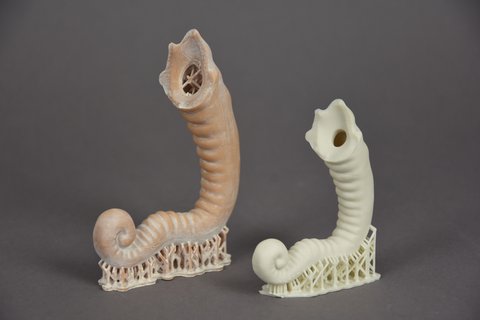
3D-Drucke des Rüssels mit Stützstrukturen vor und nach dem Brennen © Staatliche Kunstsammlungen Dresden, Porzellansammlung, Foto: Heike Ulbricht
The part intended to replace the damaged work of art has to be fired individually, then attached to the porcelain object. After the replacement part has been fired, however, its shape can no longer be changed. The points where the part is attached to the objet d’art have to be a perfect match. Even the tiniest differences in shape, twists or buckling can no longer be corrected by grinding the part down, as the grains of quartz in the porcelain structure are so hard. When the replacement part is designed, the reduction in volume has to be taken into account as a factor affecting its final dimensions. The shrinkage behaviour of a ceramic material must therefore be determined very precisely in advance. Another factor affecting the elephant’s trunk that was to be built was that neither the trunk, nor the break beneath the elephant’s head had a smooth surface enabling the part to be positioned on the build platform. Thin support structures were used to create a provisional surface on which to build the trunk.
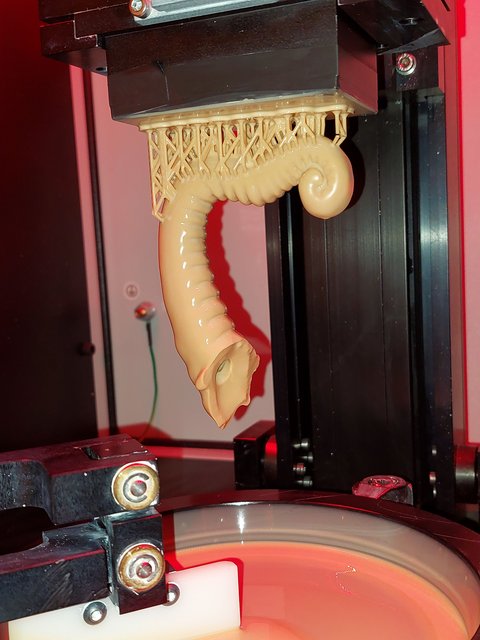
Frisch gedruckter Rüssel im 3D-Drucker des Fraunhofer IKTS © Fraunhofer IKTS, Foto: Nadine Lorenz
These support structures were kept in place when debinding and sintering the part, so that the trunk could be placed in a good position in the furnace chamber without being distorted by its own weight at a high temperature. After firing, these thin supports were removed. Conveniently, they were attached at points where they were not visible to anyone looking at the work of art. It goes without saying that items of porcelain cannot be taken from the collection and brought to a technical centre so that the replacement part can be adjusted to fit them. For that reason, the original elephant’s head was scanned and a copy also created in plastic using a 3D printing process. This plastic part was produced both in its original size and enlarged by the amount by which the ceramic would shrink. As a result, after the 3D printing and firing, trial adjustments could be made using the replacement part.
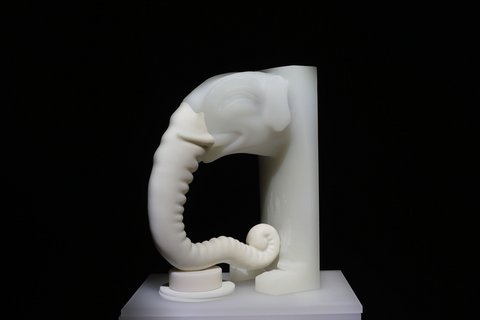
Modell des Elefantenkopfes mit dem gedruckten Rüssel © Fraunhofer IKTS
But that is not all! Initially, the trunk was manufactured as a solid part, but problems soon arose during debinding. The gaseous products produced during the decomposition of the photocurable binder could not escape from within the part fast enough, which caused defects. Following this discovery, the trunk was made hollow. Now, however, the hollow structure was not stable enough for ceramic firing. In the end, additive manufacturing saved the day again. This time, when printing the trunk, support structures were also built inside it: these posed no obstacle to the debinding and provided enough stability for the part to be fired.
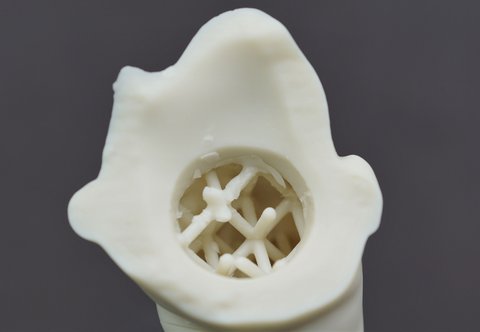
Innere Stützstruktur des gedruckten Rüssels © Fraunhofer IKTS
The restorer, Heike Ulbricht, could attach the replacement part, now free of any defects, to the historical vase. A historical porcelain item had thus been successfully restored using additive manufacturing based on the original material. Nonetheless, the process still requires further development. For example, the trunk is unglazed; it has simply been coated with white paint. The glazing step poses additional challenges relating, for example, to the colour not matching the original, or the fit at the point of a break. The replacement part selected for the project described here was also relatively small in size, with a small broken edge. The build space in an additive manufacturing system places tight limits on the size of the part. The larger the dimensions of the broken edge, the greater the risk that any slight distortion of the part during firing will be noticeable as a relatively large discrepancy, adversely affecting the fit of the finished replacement part.
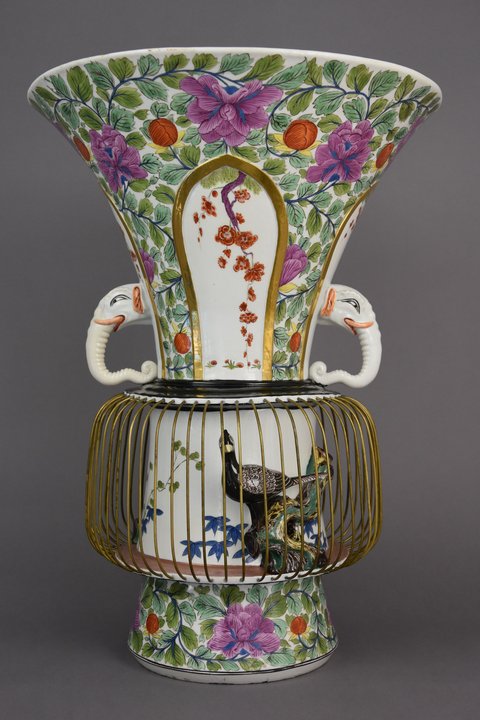
Gesamtansicht der restaurierten Vase © Staatliche Kunstsammlungen Dresden, Porzellansammlung, Foto: Heike Ulbricht
We would like to thank our partners in the project: KI Keramik-Institut GmbH, Meissen, for helping to the porcelain mixture and fire the parts, and Cox3D GmbH, for helping to scan the vase, generate the 3D data and produce the plastic mating part.
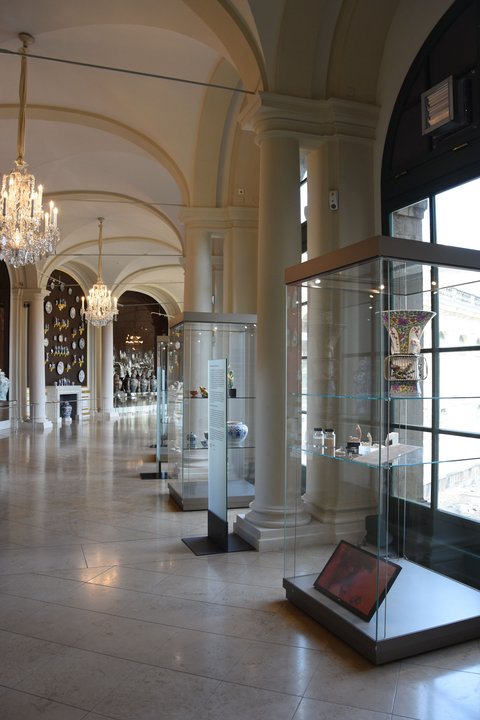
Glasvitrine mit dem restaurierten Rüssel in den Ausstellungsräumen der Porzellansammlung im Zwinger © Staatliche Kunstsammlungen Dresden, Porzellansammlung, Foto: Heike Ulbricht
Also of interest:
A Tale of Slumbering Stones
The firing of clay is one of the earliest technologies discovered or invented by man. A variety of work featuring ceramics as well as film and images created by Rome Prize winner Benedikt Hipp will be among the exhibits on display as part of the new exhibition “Eppur Si Muove – Und sie bewegt sich doch” at the Japanisches Palais (Japanese Palace), which happens to be the original location of the Porzellansammlung. In the following, Hipp offers insights into how he himself experiences and observes the creation of his ceramics – from collecting clay to the fired object.
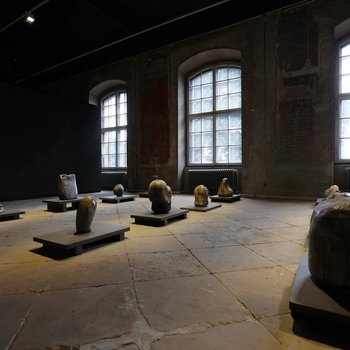
COVETED MATERIAL AT OBJEKT KLEIN A
The Porzellansammlung has used photogrammetry to digitize a selection of its objects. The Dresden nightclub “objekt klein a” has done the same with its premises, leading to an unusual 3D combination.
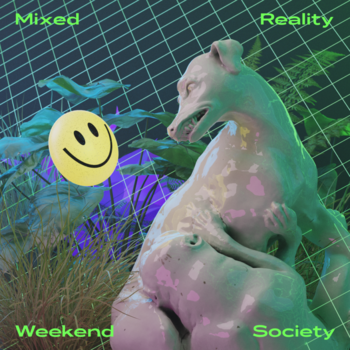
A Masterwork Comes to Light Again
With an extensive restoration at the Kaiserzimmer – previously known as the Weinling-Zimmer – this important suit of chambers, located in the west wing of the Bergpalais, Schloss Pillnitz, is again part of the visitors’ trajectory at the Kunstgewerbemuseum. Now that these outstanding rooms of early neoclassical style shine again in their former glory, they also attest to a history full of turns. Christiane Ernek-van der Goes on the cultural history of this masterwork. A reprint from our blog.
